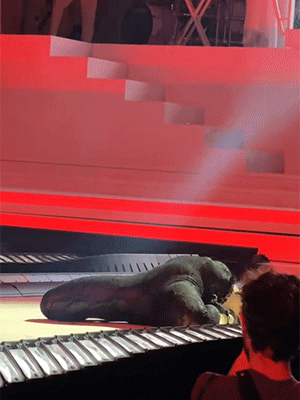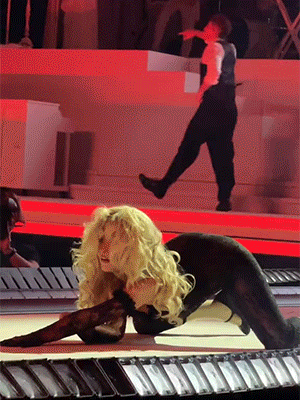Well, I Heard You're Back Together And If That's True You'll Just Have To Taste Me When He's Kissin'


Well, I heard you're back together and if that's true You'll just have to taste me when he's kissin' you If you want forever, I bet you do (I bet you do) Just know you'll taste me too
SABRINA CARPENTER and JENNA ORTEGA — Sabrina Carpenter: Taste (Official Video)
More Posts from Kiatomyheart and Others



JENNA ORTEGA🩸 Taste (2024) Scream VI (2023) Wednesday (2022)






Short N Sweet Tour / MSG









jiuzhaigou九寨沟, sichuan province in china

Deniz Burnham
A former NASA intern, Deniz Burnham started her career as an engineer on an oil rig in Prudhoe Bay, Alaska, and went on to lead operations on drilling rigs in Canada, Ohio, and Texas. https://go.nasa.gov/3wDpfBo
Make sure to follow us on Tumblr for your regular dose of space!










Untitled painting by Daniel F. Gerhartz/ excerpts from 'Text me when you get home' by Kayleen Schaefer/ 'Hinds feet' by Daniel F. Gerhartz

Monica Bellucci for Esquire Magazine (2010) Photography: Fabrizio Ferri

The Nancy Grace Roman Space Telescope’s flight harness is transferred from the mock-up structure to the spacecraft flight structure.
Your Body is Wired Like a NASA Space Telescope. Sort Of.
If our Nancy Grace Roman Space Telescope were alive, its nervous system would be the intricate wiring, or “harness,” that helps different parts of the observatory communicate with one another. Just like the human body sends information through nerves to function, Roman will send commands through this special harness to help achieve its mission: answering longstanding questions about dark energy, dark matter, and exoplanets, among other mind-bending cosmic queries.
Roman’s harness weighs around 1,000 pounds and is made of about 32,000 wires and 900 connectors. If those parts were laid out end-to-end, they would be 45 miles long from start to finish. Coincidentally, the human body’s nerves would span the same distance if lined up. That’s far enough to reach nearly three-fourths of the way to space, twice as far as a marathon, or eight times taller than Mount Everest!

An aerial view of the harness technicians working to secure Roman’s harness to the spacecraft flight structure.
Over a span of two years, 11 technicians spent time at the workbench and perched on ladders, cutting wire to length, carefully cleaning each component, and repeatedly connecting everything together.
Space is usually freezing cold, but spacecraft that are in direct sunlight can get incredibly hot. Roman’s harness went through the Space Environment Simulator – a massive thermal vacuum chamber – to expose the components to the temperatures they’ll experience in space. Technicians “baked” vapors out of the harness to make sure they won’t cause problems later in orbit.

Technicians work to secure Roman’s harness to the interior of the spacecraft flight structure. They are standing in the portion of the spacecraft bus where the propellant tanks will be mounted.
The next step is for engineers to weave the harness through the flight structure in Goddard’s big clean room, a space almost perfectly free of dust and other particles. This process will be ongoing until most of the spacecraft components are assembled. The Roman Space Telescope is set to launch by May 2027.
Learn more about the exciting science this mission will investigate on X and Facebook.
Make sure to follow us on Tumblr for your regular dose of space!












Shangri-la香格里拉, yunnan province and Daocheng Yading稻城亚丁, sichuan province in china
-
 aguywithms reblogged this · 3 weeks ago
aguywithms reblogged this · 3 weeks ago -
 konigssweatyhood liked this · 3 weeks ago
konigssweatyhood liked this · 3 weeks ago -
 idek1man reblogged this · 3 weeks ago
idek1man reblogged this · 3 weeks ago -
 alexmoant liked this · 4 weeks ago
alexmoant liked this · 4 weeks ago -
 noahbudie liked this · 1 month ago
noahbudie liked this · 1 month ago -
 starrick1943v2 liked this · 1 month ago
starrick1943v2 liked this · 1 month ago -
 dashingdot reblogged this · 1 month ago
dashingdot reblogged this · 1 month ago -
 thingshavechangedbobby liked this · 1 month ago
thingshavechangedbobby liked this · 1 month ago -
 etharas liked this · 1 month ago
etharas liked this · 1 month ago -
 raelauren liked this · 1 month ago
raelauren liked this · 1 month ago -
 c-lestes liked this · 1 month ago
c-lestes liked this · 1 month ago -
 pearlsintheshower reblogged this · 1 month ago
pearlsintheshower reblogged this · 1 month ago -
 campbelldanielle reblogged this · 1 month ago
campbelldanielle reblogged this · 1 month ago -
 curved-dick-nick reblogged this · 1 month ago
curved-dick-nick reblogged this · 1 month ago -
 sunsetzfr liked this · 1 month ago
sunsetzfr liked this · 1 month ago -
 jvelas322 liked this · 1 month ago
jvelas322 liked this · 1 month ago -
 lvsbeelz liked this · 1 month ago
lvsbeelz liked this · 1 month ago -
 freshfromhell liked this · 1 month ago
freshfromhell liked this · 1 month ago -
 justice4billiam liked this · 1 month ago
justice4billiam liked this · 1 month ago -
 freshfromhell reblogged this · 1 month ago
freshfromhell reblogged this · 1 month ago -
 rebeccaquins reblogged this · 1 month ago
rebeccaquins reblogged this · 1 month ago -
 aswad13 liked this · 1 month ago
aswad13 liked this · 1 month ago -
 lottieaegyo reblogged this · 2 months ago
lottieaegyo reblogged this · 2 months ago -
 optimisticgoopmuffinplaid liked this · 2 months ago
optimisticgoopmuffinplaid liked this · 2 months ago -
 baileynoble liked this · 2 months ago
baileynoble liked this · 2 months ago -
 d3licateflowers liked this · 2 months ago
d3licateflowers liked this · 2 months ago -
 bobbiebulger liked this · 2 months ago
bobbiebulger liked this · 2 months ago -
 pyropelove413 liked this · 2 months ago
pyropelove413 liked this · 2 months ago -
 eusuntgratie liked this · 2 months ago
eusuntgratie liked this · 2 months ago -
 dysphoria-things liked this · 2 months ago
dysphoria-things liked this · 2 months ago -
 femslashrevolution reblogged this · 2 months ago
femslashrevolution reblogged this · 2 months ago -
 davidphillipsknew reblogged this · 2 months ago
davidphillipsknew reblogged this · 2 months ago -
 gloryown-tba liked this · 2 months ago
gloryown-tba liked this · 2 months ago -
 clairedelune-13 reblogged this · 2 months ago
clairedelune-13 reblogged this · 2 months ago -
 ghostingdream reblogged this · 2 months ago
ghostingdream reblogged this · 2 months ago -
 yelenaxxbelova reblogged this · 2 months ago
yelenaxxbelova reblogged this · 2 months ago -
 aequilibriuum liked this · 2 months ago
aequilibriuum liked this · 2 months ago -
 instantpizzagladiator liked this · 2 months ago
instantpizzagladiator liked this · 2 months ago -
 lowell25 reblogged this · 2 months ago
lowell25 reblogged this · 2 months ago -
 lowell25 liked this · 2 months ago
lowell25 liked this · 2 months ago -
 frenchgangang liked this · 2 months ago
frenchgangang liked this · 2 months ago
